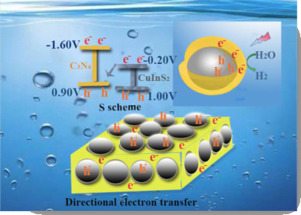当前位置:
X-MOL 学术
›
Chin. J. Catal.
›
论文详情
Our official English website, www.x-mol.net, welcomes your
feedback! (Note: you will need to create a separate account there.)
The embedded CuInS2 into hollow-concave carbon nitride for photocatalytic H2O splitting into H2 with S-scheme principle
Chinese Journal of Catalysis ( IF 15.7 ) Pub Date : 2020-01-01 , DOI: 10.1016/s1872-2067(19)63490-x Jinhua Luo , Zhexing Lin , Yan Zhao , Shujuan Jiang , Shaoqing Song
Chinese Journal of Catalysis ( IF 15.7 ) Pub Date : 2020-01-01 , DOI: 10.1016/s1872-2067(19)63490-x Jinhua Luo , Zhexing Lin , Yan Zhao , Shujuan Jiang , Shaoqing Song

|
Abstract It is still a great challenge to effectively optimize the electronic structure of photocatalysts for the sustainable and efficient conversion of solar energy to H2 energy. To resolve this issue, we report on the optimization of the electronic structure of hollow-concave carbon nitride (C3N4) by deviating the sp2-hybridized structure of its tri-s-triazine component from the two-dimensional plane. The embedded CuInS2 into C3N4 (CuInS2@C3N4) demonstrates an increased light-capturing capability and the promoted directional transfer of the charge carrier. Research results reveal that the hollow structure with an apparent potential difference between the concave and convex C3N4 drives the directional transfer of the photoinduced electrons from the Cu 2p orbital of CuInS2 to the N 1s orbital of C3N4 with the S-scheme principle. The H2 evolution efficiency over CuInS2@C3N4 is up to 373 µmol·h−1 g−1 under visible irradiation, which is 1.57 and 1.35 times higher than those over the bulk g-C3N4 with 1 wt% Pt (238 µmol·h−1 g−1) and g-C3N4 with 3 wt% Pd (276 µmol·h−1 g−1), respectively. This suggests that the apparent potential difference of the hollow C3N4 results in an efficient reaction between the photogenerated electrons and H2O. This work supplies a new strategy for enhancing the sustainable solar conversion performance of carbon nitride, which can also be suitable for other semiconductors.
中文翻译:

将 CuInS2 嵌入空心凹面氮化碳中,利用 S 型原理光催化 H2O 分解为 H2
摘要 有效优化光催化剂的电子结构以实现太阳能可持续高效地转化为氢气仍然是一个巨大的挑战。为了解决这个问题,我们报告了通过从二维平面偏离其 tri-s-triazine 组分的 sp2 杂化结构来优化空心-凹面氮化碳 (C3N4) 的电子结构。将 CuInS2 嵌入 C3N4 (CuInS2@C3N4) 中表现出增强的光捕获能力和电荷载流子的定向转移。研究结果表明,凹面和凸面C3N4之间具有明显电位差的中空结构驱动光生电子从CuInS2的Cu 2p轨道定向转移到C3N4的N 1s轨道,采用S型原理。在可见光照射下,CuInS2@C3N4 上的 H2 析出效率高达 373 µmol·h−1 g−1,是具有 1 wt% Pt 的块体 g-C3N4(238 µmol·h−)的 1.57 和 1.35 倍。 1 g-1) 和 g-C3N4 与 3 wt% Pd (276 µmol·h-1 g-1),分别。这表明空心 C3N4 的表观电位差导致光生电子和 H2O 之间的有效反应。这项工作为提高氮化碳的可持续太阳能转换性能提供了一种新策略,也适用于其他半导体。这表明空心 C3N4 的表观电位差导致光生电子和 H2O 之间的有效反应。这项工作为提高氮化碳的可持续太阳能转换性能提供了一种新策略,该策略也适用于其他半导体。这表明空心 C3N4 的表观电位差导致光生电子和 H2O 之间的有效反应。这项工作为提高氮化碳的可持续太阳能转换性能提供了一种新策略,也适用于其他半导体。
更新日期:2020-01-01
中文翻译:

将 CuInS2 嵌入空心凹面氮化碳中,利用 S 型原理光催化 H2O 分解为 H2
摘要 有效优化光催化剂的电子结构以实现太阳能可持续高效地转化为氢气仍然是一个巨大的挑战。为了解决这个问题,我们报告了通过从二维平面偏离其 tri-s-triazine 组分的 sp2 杂化结构来优化空心-凹面氮化碳 (C3N4) 的电子结构。将 CuInS2 嵌入 C3N4 (CuInS2@C3N4) 中表现出增强的光捕获能力和电荷载流子的定向转移。研究结果表明,凹面和凸面C3N4之间具有明显电位差的中空结构驱动光生电子从CuInS2的Cu 2p轨道定向转移到C3N4的N 1s轨道,采用S型原理。在可见光照射下,CuInS2@C3N4 上的 H2 析出效率高达 373 µmol·h−1 g−1,是具有 1 wt% Pt 的块体 g-C3N4(238 µmol·h−)的 1.57 和 1.35 倍。 1 g-1) 和 g-C3N4 与 3 wt% Pd (276 µmol·h-1 g-1),分别。这表明空心 C3N4 的表观电位差导致光生电子和 H2O 之间的有效反应。这项工作为提高氮化碳的可持续太阳能转换性能提供了一种新策略,也适用于其他半导体。这表明空心 C3N4 的表观电位差导致光生电子和 H2O 之间的有效反应。这项工作为提高氮化碳的可持续太阳能转换性能提供了一种新策略,该策略也适用于其他半导体。这表明空心 C3N4 的表观电位差导致光生电子和 H2O 之间的有效反应。这项工作为提高氮化碳的可持续太阳能转换性能提供了一种新策略,也适用于其他半导体。











































 京公网安备 11010802027423号
京公网安备 11010802027423号